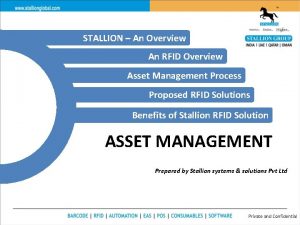SEMICLOSED CASTRATION IN A STALLION GENERAL INFORMATION Semiclosed





![REFERENCES • Themes UFO. 16. Surgery of the Stallion Reproductive Tract [Internet]. Veterian Key. REFERENCES • Themes UFO. 16. Surgery of the Stallion Reproductive Tract [Internet]. Veterian Key.](https://slidetodoc.com/presentation_image_h2/ebcaf69a8e90b8f309d14ef102bc81c4/image-6.jpg)
- Slides: 6

SEMI-CLOSED CASTRATION IN A STALLION

GENERAL INFORMATION • Semi-closed castration is also known as the modified closed castration method • It is done under general anesthesia • Opening of the vaginal tunic allows for observation of enclosed structures such as the spermatic vessels, epididymis and ductus deferens. • 3 major ligaments (remnants of the Gubernaculum) need to be ruptured: ü The proper ligament of the testes ü The ligament of the tail of the epididymis ü Scrotal ligament • The use of ligatures can be applied for mature stallions

STEPS INVOLVED • Blunt dissection of the spermatic sac by cutting through the skin, tunica dartos and the spermatic facia using a scalpel • Tense the median raphe and pull the cranial end of the sheath in a forward and upward direction. • A longitudinal incision is made roughly 4 cm from the median raphe • The vaginal process is separated from the skin by tearing the scrotal ligament using your fingers • The vaginal process is incised in a manner that is cranial to and just above the testicles Image 1: Longitudinal incision being made

• Extrude the testicles and epididymis through the incision. The fundus becomes inverted and exits through the incision because the fundus of the vaginal tunic is affixed by the ligament of the tail of the epididymis to the epididymis and testis • Tension is maintained on the vaginal tunic while traction is applied to the spermatic cord using the thumb • The spermatic blood vessels are ligated and divided • The entire vaginal process is ligated • Blunt dissection of the spermatic cord and cremaster muscle from the scrotal facia is performed and transaction near the superficial inguinal ring is applied using an emasculator ABOVE: Image 2: Insertion of thumb into incision of the parietal tunic and into vaginal cavity BELOW: Image 3: Exteriorization of parietal tunic (P) and testis (T)

• Emasculation is performed to remove the distal vaginal process which contains the testicle and epididymis • The Emasculator is placed in a “nut to nut” position • It must be ensured that it is positioned in a transverse direction and reduce the entanglement of any skin between the emasculator • Once the emasculator is closed, crushing occurs for 30 seconds to 1 minute Image 4: Placement of the emasculator
![REFERENCES Themes UFO 16 Surgery of the Stallion Reproductive Tract Internet Veterian Key REFERENCES • Themes UFO. 16. Surgery of the Stallion Reproductive Tract [Internet]. Veterian Key.](https://slidetodoc.com/presentation_image_h2/ebcaf69a8e90b8f309d14ef102bc81c4/image-6.jpg)
REFERENCES • Themes UFO. 16. Surgery of the Stallion Reproductive Tract [Internet]. Veterian Key. 2016 [cited 2020 Oct 17]. Available from: https: //veteriankey. com/16 -surgery-of-the-stallion-reproductive-tract/ • Kilcoyne I. Equine castration: A review of techniques, complications and their management [Internet]. UC Davis. British Equine Veterinary Association; [cited 2020 Oct 17]. Available from: https: //ucdavis. pure. elsevier. com/en/publications/equine-castration-a-review-of-techniquescomplications-and-their-











